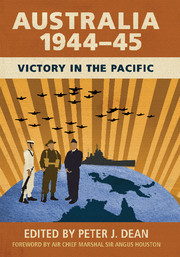Book contents
- Frontmatter
- Dedication
- Foreword
- Contents
- Maps and chart
- Figures and table
- Contributors
- Acknowledgements
- Abbreviations
- Military symbols on maps
- Introduction
- PART 1 STRATEGY
- 1 Advancing National Interests: Deciding Australia's War Strategy, 1944–45
- 2 The Southwest Pacific Area: Military Strategy and Operations, 1944–45
- 3 Holding on to the Finish: The Japanese Army in the South and Southwest Pacific, 1944–45
- PART 2 AUSTRALIA AT WAR
- PART 3 GREEN ARMOUR AND SPECIAL OPERATIONS
- PART 4 THE NAVAL AND AIR WAR
- PART 5 THE NEW GUINEA CAMPAIGN
- PART 6 THE BORNEO CAMPAIGN
- Afterword: And Then Came Peace?
- Index
- References
2 - The Southwest Pacific Area: Military Strategy and Operations, 1944–45
from PART 1 - STRATEGY
Published online by Cambridge University Press: 05 December 2015
- Frontmatter
- Dedication
- Foreword
- Contents
- Maps and chart
- Figures and table
- Contributors
- Acknowledgements
- Abbreviations
- Military symbols on maps
- Introduction
- PART 1 STRATEGY
- 1 Advancing National Interests: Deciding Australia's War Strategy, 1944–45
- 2 The Southwest Pacific Area: Military Strategy and Operations, 1944–45
- 3 Holding on to the Finish: The Japanese Army in the South and Southwest Pacific, 1944–45
- PART 2 AUSTRALIA AT WAR
- PART 3 GREEN ARMOUR AND SPECIAL OPERATIONS
- PART 4 THE NAVAL AND AIR WAR
- PART 5 THE NEW GUINEA CAMPAIGN
- PART 6 THE BORNEO CAMPAIGN
- Afterword: And Then Came Peace?
- Index
- References
Summary
On Thursday 7 October 1943 two senior officers, one Australian and one American, held meetings in their respective headquarters. Even though some 2000 kilometres of the Coral Sea separated them, they were linked by a common cause and a common role. They were both senior operations officers of their respective headquarters in the Southwest Pacific Area (SWPA). US Brigadier-General Stephen Chamberlin was the senior operations officer for General Douglas MacArthur, the theatre Commander-in-Chief (C-in-C). The Australian Major-General Frank Berryman was the Deputy Chief of the General Staff responsible to the C-in-C General Sir Thomas Blamey, while concurrently also holding down the position of senior staff officer of New Guinea Force (NGF), the Australian Army formation fighting the Japanese in New Guinea.
On the morning of 7 October, Berryman sat in a tropical bungalow in Port Moresby, Papua, that served as the headquarters of NGF. Across from him sat Lieutenant-General Iven Mackay, or ‘Mister Chips’, as he was known, whom Blamey had installed as the General Officer-in-Command (GOC-in-C) New Guinea Force six weeks earlier. With them was Lieutenant-General Leslie Morshead, the ‘hero of Tobruk and El Alamein’ and commander of II Australian Corps.
Despite the fact that the three men had served together in the Australian Army for decades, had a close rapport and a high degree of mutual respect for one another, the atmosphere was tense. Morshead was about to fly out to relieve Lieutenant-General Edmund Herring of his command. Herring was the commander of I Corps, whose troops were in the frontline in the Markham Valley and Huon Peninsula fighting the Japanese. Berryman had held reservations over Herring's suitability for his command for some months and in September, after Herring had mishandled relations with the Americans, lost ‘grip’ of his operations and openly criticised Mackay, Berryman advised Blamey that he lad lost all confidence in him. He told Blamey that he did not think that Herring was ‘tough enough mentally’ for the job. Major-General Vasey, General Officer Commanding (GOC) of the 7th Australian Division in Herring's Corps was even more frank. He recorded that Herring's ‘trouble is a lack of decision occasioned by a lack of knowledge and combined with wishful thinking and optimism’. He is ‘incapable of training a staff … [and] good deal of our recent problems are his doing … Ned is a nice man but the army is not the place for those people’.
- Type
- Chapter
- Information
- Australia 1944–45Victory in the Pacific, pp. 28 - 50Publisher: Cambridge University PressPrint publication year: 2015



